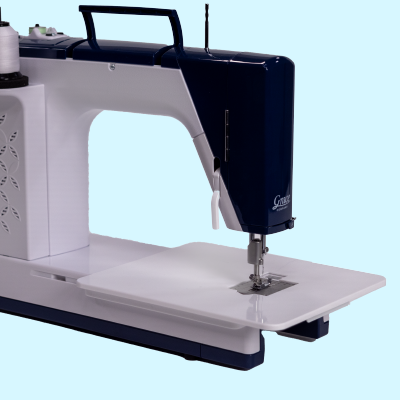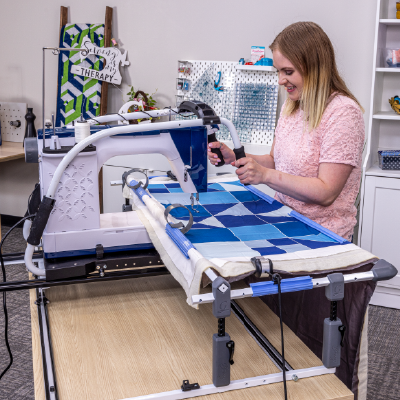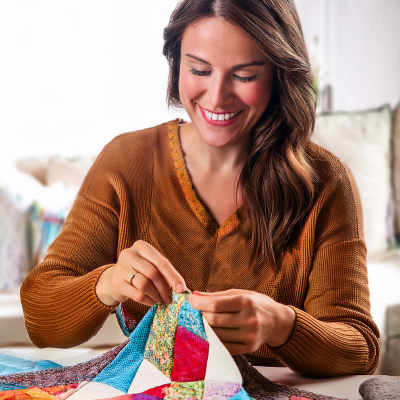7 Life-Saving Tips for Quilting without a Longarm Machine
Sure, you’ve been piecing quilts on your trusty sewing machine for years, but if you thought that the actual quilting had to be done by hand, on a longarm quilting machine, or with ties, think again.
Plenty of talented quilters work exclusively on domestic machines, making everything from baby quilts all the way up to king size. All it takes is the bravery to begin, practice, and of course, a few tips to set yourself up for success won’t hurt.
1. Create a Machine Quilting Setup That Works for You
Take the time to think about where the rest of your quilt will be when you’re actively quilting. You’ll want to make sure you have adequate room behind the machine. This might mean setting up your machine on one end of your table, so that the quilt can pile up on the rest of the table while you work. If the table you’re working on is small, you may want to pull it away from the wall, so the fabric can spill over the side of the table and drape to the floor.
Adding an extension table to your sewing machine essentially expands the base of your sewing machine, so that you can more comfortably work with your fabric as you push it through the machine.
There are also purpose-built sewing tables that have an inset area. When you place your sewing machine into the inset, the sewing machine base becomes level with the table. Without having to maneuver your fabric over the base, it will be easier to achieve smooth, cohesive quilting.
Make sure that your quilting table and your chair height are set up for the most comfortable, ergonomic quilting possible. Make sure that your arms are at a 90° angle, or greater, so that you’re not hunched into an uncomfortable position.
2. Prepare for Either Straight-Line or Free-Motion Quilting
The optimal machine quilting setup for you depends on the look you want for your quilting project. Straight-line quilting and free-motion quilting each require somewhat different preparation.
If you’re looking to quilt straight lines, there’s no need to drop the feed dogs on your sewing machine. They will help you push your quilt through the machine with less effort. Using a walking foot will help you achieve more consistent stitch length while you quilt.
For curvy free-motion designs, on the other hand, you will want to drop the feed dogs on your machine, so they don’t fight to pull your quilt sandwich in a different direction when you’re quilting. Use a hopping foot. This quilting foot moves up and down in time with the needle, so that the quilt sandwich is pressed together as the stitch is formed.
 3. Use the Right Tools for Quilting on a Sewing Machine
3. Use the Right Tools for Quilting on a Sewing Machine
In addition to the right sewing machine foot for the job, many machine quilters have other tools that they rely on for the best quilting experience. This step may take a little trial and error to find the tools that you like best.
When securing your quilt sandwich, some quilters get tired of pinning and unpinning their layers of fabric in place. One solution to that problem is spray basting. This is a spray adhesive that will bind together all three layers of your quilt sandwich, so you can hold your quilt top, batting, and backing in place without using dozens of pins.
Grippy gloves are a good choice for machine quilting, because you want to make sure that when you move your quilt through your machine, your design doesn’t suffer because the fabric slips through your fingers.
Adding Grace Company’s Cutie Tabletop Fabric Frame to your quilting setup allows you to experience longarm quilting on your trusty home sewing machine. Your machine sits on the carriage, so you’ll move the machine over the fabric instead of moving the fabric through the machine. Consider getting the longarm experience for hundreds instead of thousands.
4. Make Your First Machine Quilting Project Manageable
When you’re learning a new skill or diving into a new hobby, it’s best to set yourself up for little wins. When you have positive experiences early on, you’re more likely to stick with it. Because of this, we recommend that you make your first machine quilting experience a small, simple undertaking.
You might be an experienced sewist or hand-quilter, and while some of those skills will transfer to machine quilting, you should still expect there to be some learning curve. By nature, larger quilts are going to be more difficult. There’s more room for error and more fabric to manage. We don’t want you to start your first project, get discouraged, and never finish, so start small. Try out a baby quilt before you move to a king-size quilt.
5. Quilt the Center First, Then Work Your Way Out
The center of the quilt is the most difficult to tackle. This is the point in the quilt where you’ll have the most fabric bunched up in the throat of your machine, and there’s more fabric to pull around to get the design you want.
Starting at the center of your quilt lets you get the most difficult part over with early, but it also helps your quilt shift evenly as you work, so you don’t end up with all of the shifting on one side or in one corner of the quilt.
Alternatively, you can stitch in a ditch before you start quilting so that your quilt sandwich doesn’t move around while you’re concentrating on your design.
6. Your Motifs Can’t Be Bigger Than Your Workspace
Keep in mind how much space you will have before you have to move your quilt aside again. You won’t be able to make fluid quilted motifs larger than that space. Don’t make the designs you’re trying to achieve larger than the space you have.
7. Take It Slow, Take Breaks, Go Easy on Yourself
Don’t forget that you are building a new skill, and it’ll take some time to get the hang of it. That’s okay! That’s the beauty of learning something new: finding all the little quirks that will become a part of your process to make quilting more enjoyable for you.
Make sure that you don’t try to rush through the process. You may not be able to quilt at the same pace you’re used to sewing, and that’s okay! Just take it slow until you get comfortable with the motions and develop the muscle memory you need to manage your fabric as you go.
Don’t forget to take breaks! Moving all that heavy fabric around is a lot of work, and with some of it piling on your lap, it’s sweaty work too. Step away from the machine every so often to stretch, get a drink of water, or just reset if you’re feeling frustrated.
Most Importantly… Just Start
Every machine quilter starts as a beginner, and if you never start, you’ll never get better. The first step can be intimidating, but the best way to get better at machine quilting isn’t by reading tips and tricks or watching YouTube videos or asking your quilting friends (though all of those things are fabulous resources!), the best way to improve is to practice.
So, what are you waiting for? Start quilting!
Posted by The Grace Company
For over 25 years the Grace Company has been the leading manufacturer of high quality quilting frames and quilting accessories. What truly sets The Grace Company apart from other competitors is its level of quality, value, and experience toward all their endeavours. From products to external and internal customer experience, the Grace Company responds to market and customer needs and continues to lead the quilting industry. Grace Company frames and hoops are designed to be easy to build and compatible with most major quilting machines. They'll have the quilting product you need.



